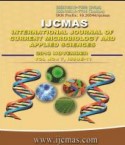


 National Academy of Agricultural Sciences (NAAS)
National Academy of Agricultural Sciences (NAAS)

|
PRINT ISSN : 2319-7692
Online ISSN : 2319-7706 Issues : 12 per year Publisher : Excellent Publishers Email : editorijcmas@gmail.com / submit@ijcmas.com Editor-in-chief: Dr.M.Prakash Index Copernicus ICV 2018: 95.39 NAAS RATING 2020: 5.38 |
Growth, biomass, carbon storage and allometric relations for estimating stem volume and aboveground biomass on the basis of DBH and Height of tree and growth pattern curve, carbon storage and developed various allometric equations on selected Agroforestry trees. Total seven species including 210 trees were marked selected in the present study. The maximum adjust R2 found in; Albizia chinensis where quadratic function showed the highest adj R2 (0.993) on the basis of DBH and according to the height of tree (H), the best fit was also quadratic, which showed adj R2 in the value of (0.695), on the other hand for six species trees, power function was the best significant equation which modified the highest adj R2 for the following specieses, that are Albizia lebbeck (0.964), Acacia mollissima (0.992), Melia composita (0.990), Dalbergia sissoo (0.992), Toona ciliata (0.888) and Ulmus villosa (0.990) recorded on the basis of DBH, however, to the height of tree as an independent variable, the best equation was sigmoid which showed the adj R2 value in Albizia lebbeck (0.480), Acacia mollissima (0.530), Melia composita (0.598), Dalbergia sissoo (0.551), Toona ciliata (0.645) and Ulmus villosa (0.597). The total biomass (AGB + BGB) was calculated using specific gravity and root-shoot ratio. Branch and leaves biomass of each species was estimated using biomass expansion factor (BEF) of trees as per the guidelines of IPCC (2003). All biomass values were converted to tree biomass carbon by multiplying factor of 0.5. However, in this research, equation selection was based on adjust R2 and minimum standard error.
 |
 |
 |
 |
 |